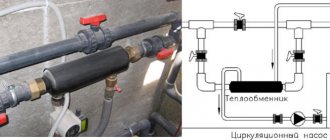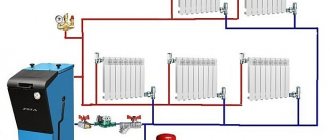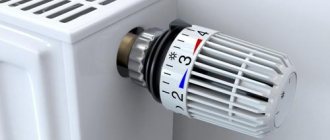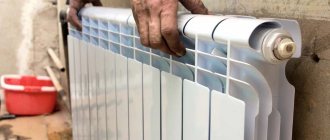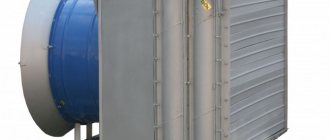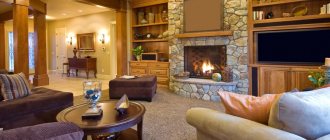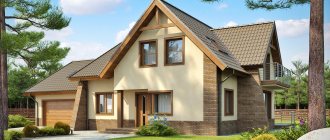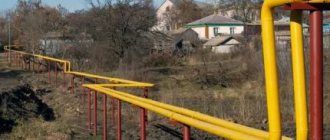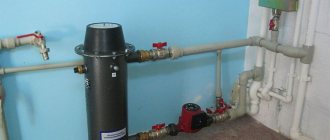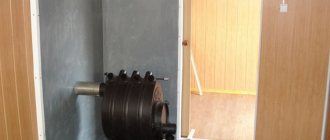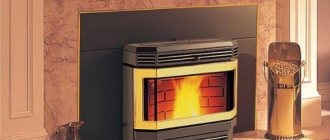Gas heating and its features
If you want to heat your house economically and have gas supplied to your property, choose a gas heating system. It is suitable for those who plan to live in a country house in cold weather or often travel to the countryside. The possibility of installation depends on whether there is a gas pipeline nearby and whether your dacha is a permanent building.
The basis of such a heating system is:
- a gas boiler;
- water flowing through pipes.
The system is connected to the gas pipeline and it begins its work. Heat enters the house constantly. Compared to electricity costs, it can be called cheap, but the system must be constantly monitored. If you will be away for a long time, you should drain all batteries before leaving home. When the boiler is not working, the water in the pipes freezes and they may burst.
Attention! To insert and install a boiler, you must obtain permission from the gas service. Installation is carried out only by professionals.
There is another way to heat a dacha in winter without electricity. You can buy compressed gas cylinders. This is cheap and convenient if communications are located far from your dacha and you cannot connect it to them. Gas cylinders are connected to the boiler. For this, a gearbox is used. Such heating is economical and does not pollute the environment. The main thing is to monitor the condition of the system, observing safety precautions. If necessary, this equipment can be easily adapted for connection to the central gas supply.
Water heating
If you are interested in how to heat your dacha in winter with greater comfort, then we can recommend using heating boilers. Yes, their installation and installation of related equipment will take more time and effort, as well as money. But you can be sure that all rooms will be warm and cozy, and you will have to put a minimum of effort and time into this.
Water heating system for a country house
Depending on the fuel used, heating boilers are usually divided into several types:
- diesel,
- gas,
- solid fuel.
Diesel boilers remain one of the most common in our country. But, basically, this is a legacy of bygone decades. Today, diesel fuel is very expensive, so only very wealthy people can afford to heat their homes in this way. Otherwise, such boilers do not have serious drawbacks. The only one is the unpleasant, acrid, oily smoke. You have to extend the chimney above the roof level, otherwise soot appears on the walls, which is quite difficult to get rid of, and the constant smell of burning will probably not please any of the inhabitants of the dacha.
An even better solution would be to install the boiler in a small extension 5-15 meters from the house, if the size of the plot allows it.
The advantages of diesel boilers are quite numerous. Diesel fuel can be stored in a large tank (several tons) buried on the property, close to the house, in order to be self-sufficient. High energy intensity allows you to burn relatively little fuel to maintain the desired temperature level in the house. The fuel is supplied by itself, thanks to which the temperature in the premises remains practically unchanged all day, and a person does not need to take part in this process.
Gas boilers are becoming increasingly popular these days. Today, most of the country is gasified, and even in small villages people have access to gas. Its cost is significantly lower than the cost of diesel fuel, and their energy intensity is quite comparable.
Gas boiler operation diagram
Otherwise, gas is even better than diesel fuel. It does not smoke when burned, which many users like. It is not necessary to have large reserves of gas if there is a connection to a gas pipeline.
The only disadvantage of this type of fuel is the risk of explosion. A tiny leak, which can occur due to improper installation or accidental breakdown, is enough for the owners to get a real bomb at their side. This scares off many potential owners. Although in most cases this danger is reduced to almost zero. To do this, experts recommend installing gas heating boilers not in basements, but in separate buildings. It is very important to ensure good ventilation in this room. Then the possibility of gas accumulation to a dangerous concentration is completely eliminated.
Electric boiler
Unlike a gas system, an electric boiler is compact and easy to operate. There are different models of electric boilers. The power of the unit is selected depending on the area of the room. Electricity heats the air, then a pump pumps it throughout the heating system. Heated air constantly circulates in a confined space, heating the house.
If you place the boiler in the basement, it does not take up space in the house, but this is fraught with large heat losses. A lot of heat will be spent heating the basement. When planning a house, it is better to allocate a separate room for the boiler, adjacent to the residential sector. Thus, you will ensure high heat transfer with minimal heat loss and save electricity.
Electric boilers operate silently, do not emit any odor, and are easy to install and operate. The specifics of their connection should be taken into account. For example, if your boiler is low-power (3.5-7 kW), it needs to be allocated a separate branch from the distribution panel and installed automatic protection. A powerful unit (from 7 kW and more) is connected only to a three-phase network.
The only disadvantage of an electric heating system is its high price, but people often use it because of its convenience and ease of installation.
Liquid fuel boilers for heating
A steel or cast iron boiler is connected to a water heating system. The following is used as fuel for such boilers:
- diesel;
- kerosene;
- processed oils;
- fuel oil.
To install the system, you also need a separate room, since we are talking about bulky and massive equipment.
There are single-circuit and double-circuit boilers. A unit with one circuit heats only the coolant. The dual-circuit model can heat both coolant and hot water. Any water heater (storage or flow-through) can be connected to it. Place the equipment on the wall or floor. Boilers that are placed on the floor are massive and heavy and make a lot of noise when operating. When installing them, additional equipment is used, which requires a lot of space. When operating liquid fuel units, soot and foreign odors always appear, so you must immediately take care of installing ventilation.
If you have a small house, you can install a wall-mounted boiler, which does not cause any hassle during operation.
Solid fuel systems and their applications
Due to the high cost of electricity, people install solid fuel heating systems. They are similar to metal stoves, but their design is different. They use the following as fuel:
- wood waste;
- peat bog;
- briquettes with coal.
The solid fuel boiler is also connected to the pipes of the general heating system. It is reliable, easy to operate and “omnivorous”, because you can put all types of solid fuel in it. Combustible products need to be purchased with a reserve so that they do not run out suddenly. The efficiency of the unit is low, and its chamber must be cleaned regularly at the end of the combustion cycle. This inconvenience is compensated by the ease of use and “unpretentiousness” of the universal unit and its components.
The solid fuel boiler does not depend on other communications and operates for a long time after a single load. This ensures economical consumption of coal or coke. If you load it with firewood or wood waste, it works continuously for 48 hours, without the need to add fuel again.
On a note! When using coal briquettes or coal, the boiler supplies the house with heat for 5 days without interruption.
Universal boilers
They are used if you need to heat your dacha in winter without gas. A universal boiler becomes a “savior” when there are constant power outages on the site. Sometimes it is not possible to regularly buy coal for solid fuel units, and a universal system is the only way out. It can operate on the following types of fuel:
- liquefied gas;
- liquid substances;
- coal;
- firewood
The system works by heating the coolant. The boiler is equipped with several burners designed for different types of fuel. It is controlled automatically and is equipped with overheating protection, and its operation is safe for the user. To use different types of fuel, the system provides for changing settings. It regulates the operating mode of the boiler, and it always produces optimal efficiency.
How to heat a cottage in winter using gas?
If the cottage is used only for periodic stays, it may not be worth making an expensive connection to the main gas pipeline. However, it is nevertheless possible to heat the dacha with gas. Gas in cylinders will help solve the question of how to quickly heat a dacha in winter. It is quite possible to bring the cylinder with you; it is not necessary to equip a place to store it at the dacha. And thermal gas equipment is much more economical than similar electric equipment with comparable efficiency parameters. For example, a gas heat gun can heat the air in a room in a matter of minutes, while consuming very little gas. All kinds of gas convectors are also quite competitive when it comes to heating a country house.
What is the best way to heat a dacha in winter is not a simple question. Since, along with the issue of savings, there is also the issue of efficiency of heating equipment. Special requirements for the speed of heating the room, automation of the process and the final price affect the final choice of country property owners. And only a careful calculation of all conditions of use will help you make the right choice in favor of one or another method of heating your dacha in winter.
Content
Brick ovens
The main “heating unit” of a brick stove is the wood-burning firebox. Oxygen is constantly supplied to it so that the flame is at the desired level. The stove is equipped with a chimney that removes waste combustion products to the outside. If you follow these rules and regularly clean the chimney, the stove will always provide warmth to the residents of the house.
The ash pan (or blower door) provides air flow. The masonry laid inside the furnace ensures that combustion products escape outside. There are different stove designs. To heat the cottage, use one of four:
- “Dutch”;
- fireplace;
- “Swedish”;
- Russian.
The brick oven is compact. You can give it any design with your own hands, in accordance with the interior of your house or cottage. It is fireproof, and natural materials (stone, brick) are used in its production. However, building a stove requires serious skills, without which it will not be possible to create a full-fledged heating system. Making masonry is a long and labor-intensive process that requires time and skill. The cost of natural materials is high, but if you are the owner of a real stove, it will serve you for a long time. In addition, the stove does not depend on gas and electrical communications. If you have firewood and know how to heat it, it will warm a person in any cold weather.
Solid fuel
Not so long ago, solid fuel had no competitors. At first, firewood, and then coal, were the main types. Of course, they also burned peat, straw and even dung, but, as now, it was “local” fuel that was not widely used.
The primitive hearth in the cave is very reminiscent of a classic fireplace Source cottage.ru
With the beginning of the “gas era,” heating, firewood and coal faded into the background, but still remain in demand. Moreover, their prospects are “rosy”, since there are much more proven reserves of coal than gas, and firewood and “wood” fuel are renewable energy sources. The only modern difference is that previously only stoves or fireplaces were used to heat a house, but now a boiler is considered the main source of heat. Although there are exceptions.
They are still found today, especially when it comes to a small country house or dacha. The main advantage is absolute energy independence. Therefore, they are used when it is necessary to provide heating for a private home without gas or electricity.
Depending on their purpose, stoves can be either heating or heating-cooking. The first option includes a Russian stove and a Swedish stove, the second - a Dutch oven and a classic fireplace.
Heating and cooking stove Source bioenerga.gr
Their effectiveness largely depends on the design of the chimney system, of which there are three types:
- Straight-through. The chimney has a minimum number of bends in the direction from the firebox to the pipe. This category includes classic open-hearth fireplaces and Russian stoves. The radiator of heat is the body and part of the chimney that runs indoors or inside the wall. By the way, thanks to its special design and massiveness, the Russian stove is considered one of the most efficient. And a traditional fireplace has the lowest efficiency. And in modern realities it is more of a decoration or a means of relaxation while contemplating an open flame than a full-fledged heater.
- Duct. Combustion products are removed using a system of channels passing inside the furnace body, which not only emits, but also accumulates heat. The “Dutch” belongs to this type. It, like a Russian stove, takes a long time to warm up, but also takes a long time to cool down.
- Bell bells. Hot gases first rise into the “hood”, where they give up some of the heat, cool, fall along the walls of the hood and are drawn out into the chimney through the “hood”.
In addition to non-volatility, the advantage of classic stoves is their “omnivorousness” in relation to solid fuel. Firewood, coal, peat, briquettes - everything that can be put in the firebox with your hands and set on fire. Moreover, unpretentiousness extends to the ash content of coal and the moisture content of firewood.
The Russian stove is still relevant and can heat several rooms on two levels Source yandex.uz
The disadvantages are no less significant than the advantages:
- radiation type of transfer of thermal energy - one stove heats a house where the entire living area is contained in one or two adjacent rooms;
- labor-intensive maintenance - frequent refilling of fuel and cleaning;
- low efficiency (efficiency on average about 20%) - the fuel does not burn out completely and most of the heat “flies down the chimney” along with the smoke;
- a complex hand-made design that can only be performed by an experienced craftsman.
Modern solid fuel boilers and factory fireplace inserts do not have these disadvantages.
See also: Catalog of companies that specialize in insulating country houses.
Solid fuel boilers
Another not the worst option than heating the house. Modern solid fuel boilers have an efficiency of 80-95%. That is, the best examples of operating efficiency are at the level of gas boilers, and only three economic factors “throw them back” into second place:
- higher cost of coolant per kilowatt of thermal energy;
- higher price of equipment;
- “there are” maintenance costs (costs of transport, fuel storage and disposal of solid residues).
If we talk about cost, then in the Moscow region, heating with wood is approximately one and a half times more expensive than gas - about 90 kopecks. per kilowatt versus 53 kopecks. (at tariffs for natural gas for the second half of 2021, subject to the availability of metering devices).
Pyrolysis boilers have the highest efficiency - the wood in them burns almost completely, with minimal “solid” residue Source pogreb-podval.ru
The use of fuel pellets increases the cost per kilowatt to 1.3-1.4 rubles. and is almost comparable in price when using coal, but still 15-20% cheaper than heating with anthracite. But there are nuances here.
If the task is how to heat a house cheaply without gas, then long-burning wood boilers or pyrolysis (gas generator) models best meet this condition. The only drawback is that laying firewood is done manually and it is impossible to automate this process. Although this should be done infrequently - 1-2 times a day. Also keep in mind that you need to carefully check the information about the so-called “magic” long-burning wood-burning boilers.
Pellet or coal boilers are available with automatic loading of fuel from the bunker. And although the bunker also needs to be loaded manually, it is much larger than the volume of the firebox. A regular boiler model with a standard hopper with a capacity of 1 m3 can operate continuously from three days to a week, and with an enlarged hopper - up to 12 days (taking into account high-quality insulation of the house and low heat loss). And when it is not possible to frequently load fuel, then these boilers are the best option (if you do not take into account higher prices for equipment).
Long-burning solid fuel boilers with a large-capacity hopper do not require daily maintenance from the owners Source kaminyn.ru
Note. There are even automatic modular coal boilers with a bunker volume of up to 14 m3, their own crusher, auger fuel supply to the firebox and automatic soot removal into their own bunker - practically a mini-boiler room for a private home. Moreover, this is a domestic development and the cost of the equipment is also “domestic”.
Fireplace inserts
Modern fireplace inserts, fireplace stoves and stoves do not differ in operating principle from solid fuel boilers. They also have the function of long burning and secondary combustion. Their efficiency differs from gas generator boilers by only 5-10%, which is at least four times higher than that of classic fireplaces with an open firebox.
Demonstration model of a closed fireplace insert with a water circuit Source bestpechi.ru
Metal stoves
The efficiency of a metal furnace depends on the density of the fuel. There should be no free space between solid elements. Firewood inside a metal stove must be placed in a cage. The denser the filling, the longer it will burn, providing heat to the entire room. When properly stacked with firewood, a metal stove retains heat for 24 hours.
As wood smolders, it releases heat energy, and the stove has a special compartment for air supply. The characteristics of the metal affect heat transfer and thermal conductivity. Despite the weak accumulation of heat, the thermal conductivity of the metal is high. This stove produces heat efficiently, is compact, and can be installed anywhere. Cast iron stoves are reliable and last longer than products made from other materials.
Advice! You can buy a stove of an unusual shape to decorate your country house setting.
Metal stoves are not installed in large houses, because they will not provide a comfortable temperature in a building with a large area. Their safety level is lower than that of stone or brick products, but they are quite suitable for a small dacha. You need to follow safety precautions and stack firewood correctly.
Alternative Heating Methods
Sometimes at the dacha it is impossible to do without electric heaters. They are:
- infrared;
- fireplace type;
- convector;
- oil;
- ventilation.
Infrared heaters emit soft radiation that effectively warms the room. They are installed on the top of the wall or on the ceiling. Warming up occurs quickly, and there are no difficulties with adjustment. The infrared heater is easy to install and does not take up much space in the room.
Electric fireplaces are beautiful. Sometimes they are difficult to distinguish from real fireplaces or stoves. They have good heat dissipation, and if the electric fireplace has high power, the room will heat up quickly. The disadvantage of electric “ovens” is that they consume a lot of energy, especially when used regularly.
Convector heaters are highly efficient, lightweight, and can be easily installed independently. They gently heat the room and are not as energy-intensive as fireplaces. Oil units take a long time to warm up, but consume little electricity. If you urgently need to warm up the room, their use is inappropriate.
Heat fans quickly heat a room, but they make a lot of noise and absorb moisture from the air. Dry air is harmful when a fan is used for a long time and can harm people with respiratory diseases. Fans need to be monitored by turning them off periodically. For constant heating, it is better not to use heat fans.
Which heating method to choose
If you are unlucky and there is no main gas nearby and is not expected, or you use the dacha only in the summer and simply do not want to invest crazy money in gasification, heating with electricity is the only way out. The only question is which of the many heating options to choose.
Electric boiler
- Installation difficulty:
